Cattle Diseases
Lameness in Cattle
Includes the following conditions: Digital Dermatitis, Foul-in-the-Foot, Hock Damage, Hygroma, Joint Ill, Laminitis, Septic Arthritis, Slurry Heel, Sole Ulcer, Super Foul, White Line Abscess
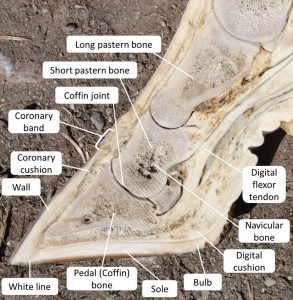
Lameness is not a single disease but a symptom associated with a range of different conditions of the foot or the leg
Lameness is a common problem in all classes of cattle and can greatly affect the welfare and productivity of the animals. Lameness is not a single disease but a symptom associated with a range of different conditions. Herd prevalence rates can vary hugely between farms because many factors can predispose clinical lameness and because of differences in stockmanship and farm environments (Vaarst et al., 1998). A recent study by Barker and colleagues who surveyed 205 dairy farms across England and Wales reports a mean prevalence of lameness as 36.8% (Barker et al., 2010). Espejo and colleagues reported a mean prevalence of 24.6% in high-producing Holstein cows housed in freestall barns in Minnesota (Espejo et al., 2006).
As well as highlighting the different factors that affect lameness, this page describes in detail the following diseases that are associated with lameness:
Yield and lameness are linked in several ways, but recent research points out an association between body condition score and lameness – thin cows are more likely to get lame (Lim et al., 2015), The proposed mechanism is that body condition score affects the thickness and quality of the digital cushion (Bicalho et al. 2009).
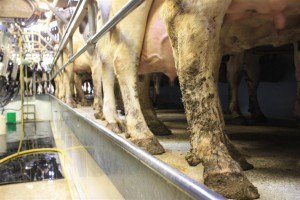
There is strong evidence to suggest that lameness is a disease of high milk production i.e., high yielding animals are at greater risk of becoming lame.
Lameness of cattle, especially in dairy herds remains a significant challenge to animal welfare. It has serious effects on dairy herd production in terms of affecting fertility and milk production parameters, with lame cows taking longer to get back in calf and requiring a greater number of services (Hernandez et al., 2001, 2002, 2005; Hultgreen et al., 2004; Sogstad et al., 2006; Walker et al., 2008, 2010), being more likely to suffer from mastitis and milk fever (Sogstad et al., 2006) and having a reduction in milk yield (Amory et al., 2008; Archer et al., 2010; Green et al., 2002; Hernandez et al., 2002 Onyiro et al., 2008; Reader et al., 2011). Lameness remains one of the major reasons for forced culling in the UK dairy herd (Forbes, 2000).
Reducing the incidence of lameness in cattle should be seen as a high priority and lameness prevention should be an integral part of any dairy herd health plan, in association with the veterinary surgeon.
Factors Affecting lameness
There are a large number of factors contributing to lameness in cattle. These can be broken down into environmental, management and animal factors, with the physiological effects of parturition suggested to be a major factor affecting lameness development (Webster et al., 2005).
Environmental Factors Affecting Lameness
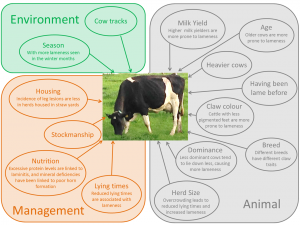
There are lots of factors that affect lameness and these can be grouped into environmental, management and animal factors
One of the most important environmental factors is season, with the risks being greater in winter than in summer (Cook, 2003; Rowlands et al., 1983) most likely reflecting the fact that most cows are housed in the winter. Wet weather conditions in winter are also conducive to maintaining high bacterial levels. Lameness in grazing cattle tends to increase about three weeks after heavy rainfall (Williams et al., 1986).
Management and Housing Factors Affecting Lameness
Stockmanship is important as farmers who know more about lameness or who have been trained tend to have lower overall prevalence of lameness in their herds than untrained herdsmen (Ward, 1999). Routine foot trimming and conformation of the foot consistently improves the shape of the foot, but is not always associated with an improvement in locomotion score. If cows are driven along stony tracks just after their feet have been trimmed, there is a risk of more lameness. If feet are trimmed when the cow is dried off, she will usually stay in one place and the risk is less (Ward, 1999).
Housing is also a significant factor. In a study by Rowlands and colleagues, the overall incidence of lesions was lower in straw yards (0.71 cases/100 cows/ month) than in cubicles with concrete yards (0.93 cases/100 cows/ month) (Rowlands et al., 1983). Another study reported that claw disorders were less frequent in cows in straw yards and at pasture compared to those on slats (Someres et al., 2003). The difference is thought to be due largely to longer lying times as cattle at pasture or those in straw yards tend to lie down for longer periods than those in cubicles or concrete yards (Ward, 1999). Straw yards also reduce the exposure to bacteria causing digital dermatitis (Laven, 1999). Cubicle lying surface can affect lameness incidence, with sand bedded cubicles associated with less lameness (Cook, 2003). Also a more recent Dutch study examining 37 dairy farms, showed that those housed in facilities with sand in the cubicles were less likely to be lame (Andreasen and Forkman, 2012).
Sand floors and rubber mats have been shown to allow the best gait from dairy cows, with slatted floors being worse for slightly lame cows (Bergsten and Telezhenko, 2005). For beef finishing animals, over-wintering outdoors was shown to reduce the incidence of white line disease compared to animals housed indoors on slats (Hickey et al., 2002).
Herd size is associated with lameness. Overcrowding, especially of first calved heifers, leads to reduced lying times and increased lameness. Vets saw proportionally fewer cases of foul-in-the-foot but more cases of sole ulcer in larger than in smaller herds (Rowlands et al., 1983).
Feed input has an important role to play in lameness associated with lesions of hoof horn and laminitis, both in terms of macro nutrient balance and trace element supply. Sudden changes from a low plane of energy pre-calving to a high plane of energy after calving may predispose to lameness (Donovan et al., 2004). Additionally, laminitis is often associated with sub-acute ruminal acidosis due to imbalances in forage and concentrate intake (Kleen et al., 2003). Although decisive evidence for a pathogenic role of endotoxins and carbohydrate overload in laminitis development is scarce (Anderson, 2003; Laven et al., 2004; Offer et al., 2004), ruminal function should be optimal to prevent lameness. Although the higher forage intakes and pasture-based systems should prevent major nutritional imbalances, this should always be checked, as imbalances can, and do, occur when at grass (Westwood et al, 2003). Much recent work has also looked at the effects of biotin on hoof horn development and subsequent lameness incidence. A review of the literature by Green and Muelling (2005) suggested that there is evidence that supplementation of cows with biotin does reduce lameness risk, although it should be remembered that biotin is not a panacea, and the prevention of lameness should be based around good husbandry principles.
Animal Factors Affecting Lameness
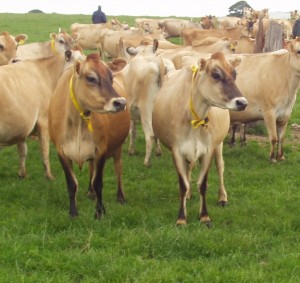
Jerseys smaller than other breeds and therefore generally lighter cows. Also they tend to have less lameness due to their harder feet.
Breed and genetic characteristics influences lameness:
- Ayrshire’s and Jerseys had better claw score traits for certain foot conditions than other breeds (Huang et al., 1995).
- Non Holstein Friesian herd had a lower risk of lameness compared to Holstein Friesian herds (Barker et al., 2010)
A study by a team of New Zealand researchers found the following:
- The Brown Swiss had the worst scores for corkscrew claws, laminitis and sole ulcers
- White line scores were worst in Guernseys
- Heel erosion and incidence of digital dermatitis were worst in Friesians
- Jerseys tend have harder feet and less lameness (Chesterton et al., 1989).
It has also been suggested that:
- Heavier cows are more prone to clinical lameness (Boettcher et al., 1998)
- Claw color has also been implicated in lameness, with cattle with less pigmented feet being more prone to lameness (Chesterton et al., 1989).
- Presence of a sole ulcer (but not heel erosion) during lactation increases the risk of a sole ulcer in the subsequent lactation. In the same study Enevoldsen et al., 1991 concluded that the interval between trimmings is important.
Age is a significant factor with regard to lameness. An initial peak in lameness occurs in young first calving heifers. There appears to be a marked reduction in horn growth in late-pregnant heifers, making them more prone to bruising and hemorrhages when housed on concrete floors. The reduced growth leads to softer horn formation, causing a weakening and possible separation at the white line and predisposing to mechanical bruising of the underlying sensitive corium (Tarlton et al., 2002). First calving heifers may be at particular risk of developing horn lesions due to sub clinical laminitis (Hobler et al., 2000) and these animals should be carefully managed as additional stress on the foot in the periparturient period may increase lameness risk (Webster et al., 2005). Older cows are mainly affected between five and eight years old (Choquette-Levi et al., 1985). Huang et al. (1995) found that the risk for six different foot disease traits increased with age.
There is evidence that low dominance-ranked cows spend less time lying down than high-ranking animals, leading to higher lameness risks (Galindo and Broom, 2000). Many foot lesions are also related to the early post-calving period. At and around calving, cows are immunosupression and may have an increased standing time which may predispose to foot lesions and lameness (Chaplin et al., 2000), therefore special care should be given to newly calved cows.
The Diseases Associated with Lameness
Lameness is not a single disease but rather a presentation associated with a range of conditions (Potterton et al., 2012). Currently in the UK, the diseases of major significance in lameness incidence are digital dermatitis, white line disease, and sole ulceration. A similar picture has been shown in the US, a survey of eight confinement dairies recorded digital dermatitis as the cause of 48% of all lameness, sole ulcer as 21% and white line disease as 17% (DeFrain et al., 2013) Over 90% of lameness involves the foot, with leg injuries being far less common. Foot problems are most often seen in the outer digit of the hind feet as these are the main weight bearing areas. Lameness lesions can be classified into four main categories: horn, skin, joint and leg problems:
Horn Diseases and Lameness
Laminitis
Laminitis is an acute or chronic inflammation of the laminae, which is the tissue lying immediately below the outer horny wall of the foot. The disease is linked to mechanical damage to the foot and to nutritional imbalances leading to poor horn growth. Sole ulceration and white zone lesions have been related to laminitis (Boosman et al., 1991). Also laminitis is often associated with ruminal acidosis although these are different conditions, they have a similar pathogenesis, specifically highly fermentable diets. However, they are not co-dependent syndromes (Lean et al., 2008). Laminitis may cause lameness in its own right, often in all four feet, but usually it is a predisposing cause or risk factor for other types of lameness lesions, such as sole ulcer and white line abscesses.
Click here to read about the treatment of laminitis
Sole ulcer
Sole ulcers are the most common disease of the foot and most typically occur in the outer claw of the hind foot. Events such as laminitis may cause the pedal bone to drop and damage the underlying horn of the sole. Abnormal claw shape has been strongly associated with sole ulcer (Manske et al., 2002a). As a result, an ulcer appears in the typical position – the center of the sole towards the heel. The ulcer sometimes appears as a hemorrhage, with a softening and yellowing of the horn, progressing to necrotic tissue and often infection. Lumps of proud flesh – granulation tissue – may protrude from the ulcer area.
Sole ulcers can cause severe milk loss (Amory et al., 2008). An association with fertility may be direct (pain and stress) or indirect, as lameness and fertility both increase with low body condition score (see above). Many sole ulcers never fully heal and cows may suffer from chronic lameness for the rest of their productive lives. Sole ulcers may also predispose other conditions, such as septic arthritis. The prevention of sole ulcer should be directed at maintaining a correct claw shape through foot trimming.
Click here to read about the treatment of sole ulcers
White line disease
The white line is the site at which the horn of the wall of the hoof joins that of the sole. It is a naturally weak area in the horn and cracks can allow dirt and bacteria to enter, causing abscess formation, pain and lameness. The initial weakness in the white line may be a result of laminitis, abnormal conformation and possibly dietary effects. The abscess most commonly occurs on the outside of the outer claw of the hind foot.
This type of lameness is the most common form of lameness in yarded cattle, especially on slats. Excessive activity on poor underfoot surfaces can lead to a high incidence of the condition. Restrictions of trough space in yarded cattle may also predispose the condition.
Click here to read about the treatment of white line disease
Slurry heel
Slurry heel is also known as heel erosion, chronic necrotic pododermatitis, chronic foot rot, and stable foot rot has been defined as “ irregular loss of the bulbar horn” (Greenough and Weaver, 1997). Almost all older cattle which are housed show some degree of heel erosion. The problem may occur in all four feet, but often it may only affect the hind feet. The lateral digit is most commonly involved. It is thought the bacterium Dichelobacter nodosus (formerly Bacteroides nodosus), an obligate anaerobic bacterium producing keratolytic enzymes that are able to erode the horn, is involved (Toussaint Raven et al., 1985). As a result, the hoof might rotate backwards and the toe may no longer be weight-bearing, the pedal bone rotates and leads to an increased risk of lameness. The predisposing factors include moist conditions which soften the horn, unhygienic conditions allowing bacterial proliferation, and overgrown feet and chronic laminitis which produce poor quality horn. Cattle fed wetter forage diets have been shown to have more severe heel erosions and lameness, therefore reducing contact with low dry matter slurry is advised to reduce lameness risk (Leach et al., 2005).
Click here to read about the treatment of slurry heel
Skin Diseases and Lameness
Digital dermatitis
Digital dermatitis (DD) is the most common skin disease of the foot often associated with housing especially in cubicles / freestalls. In the US, this condition is often referred to as ‘hairy warts’. In the UK it has been estimated that 17-20% of lameness cases are due to DD (Blowey, 2005). Young cows, cows in early lactation and those with other foot problems are more likely to suffer from DD (Holzhauer et al., 2006; Somers etc al., 2005a).
Other risk factors for DD are:
- Prolonged contact with slurry – the use of automatic slurry scrapers with inadequate drainage can easily build up a pool of slurry as deep as the heel height of a cow (Laven, 2001)
Straw yards, slatted floors and long, wide cubicles reduce DD incidence (Somers et al., 2005a; Somers et al., 2005b).
Digital dermatitis is a contagious inflammation of the epidermis. Classically, it occurs between the bulbs of the heels, is also seen to affect the interdigital space, the dew claws and the coronary band area including the anterior foot. Cases often present as an animal in extreme pain, with a red, raw necrotic area near the coronary band. It can produce two types of lesion: erosive (strawberry-like) or proliferative (wart-like). The erosive form is most common type seen in the UK, while the proliferative (‘hairy wart’) type lesions are more common in the US. The wart-like lesion occurs when the infection is not treated and is due to a chronic irritation reaction of the skin. In the USA, the ‘Dairy ’96 Study’ reported that 17.2% of US dairy cows had digital dermatitis (Clawson M. D., 2005).
Digital dermatitis is likely to be caused by infection with a spirochaete (Dhawi et al., 2005; Woodward, 1999). They have a preference for keratinized cells and produce a toxin which is keratolytic (Blowey et al., 1994). Treponeme spp. have been suggested to be the likely organisms involved, possibly in association with other bacteria such as Fusobacterium necrophorum. The immunity generated by exposure to Treponeme spp. has been suggested to be of short duration (Trott et al., 2003) therefore, cows may succumb to DD repeatedly, with exposure not guaranteeing prevention of later disease.
As well as being an extremely painful condition, which affects cow welfare, DD can have severe economic impacts on production in dairy systems (Losinger, 2006).
Click here to read about the treatment of digital dermatitis
Foul-in-the-foot
Foul-in-the-foot (also known as foot rot) is caused by an infection with Fusobacterium necrophorum, usually following damage to the interdigital skin by a foreign body. The infection results in sudden lameness, often in one limb. Body temperature is raised. There is swelling of the coronary band area, forcing the claws apart, and a split in the interdigital skin often associated with pus and dead tissue. The degenerated skin causes a ‘foul’ odor. At certain times of the year (wet, muddy and often warm at grazing) there can be herd outbreaks.
‘Super foul’ is an aggressive form of the disease that has become more common in recent years. It produces severe interdigital necrosis with rapid extension deep into the surrounding structures.
Click here to read about the treatment of foul in the foot
Joint Diseases and Lameness
Septic arthritis
Septic arthritis usually involves the pedal joint between the pedal bone and the second phalangeal bone. It results from the direct extension of infection from a foot lesion (e.g., sole ulcer or white line infection) into the surrounding tissues and eventually involving the structures such as the joint itself. It is associated with swelling of the joints, acute pain, reduced appetite, weight loss and longer periods of recumbency.
Click here to read about the treatment of septic arthritis
Joint-ill
Joint-ill is a disease of newborn calves and results from any form of septicemia that spreads to the joints of the limbs. The most common causative bacteria involved are E. coli and Streptococcus, which are found in great numbers in damp, dirty bedding. It causes severe lameness, usually in one or two joints.
Click here to read about the treatment of joint ill
Leg Injuries and Lameness
Hock damage and carpal hygromas
Hock damage (such as hygroma and traumatic arthritis) primarily results from chronic mechanical irritation due to rough floors with little or no bedding, poor cubicle or building design, and poor hygienic conditions. Heifers housed in cubicles with mattresses or in straw yards have been shown to have reduced lesions compared to heifers in cubicles only bedded with mats (Livesey et al., 2002). A hygroma is a swelling on the outside face of the hock joint and is produced by changes in the skin and underlying structures. The skin is often hairless, thickened and flaky. The underlying tissues are thickened and swollen, mainly with fibrous tissue. A cavity may develop, containing blood clots and serum, but infection often produces an abscess, which will eventually burst and drain. A fibrous lump will remain.
Click here to read about the treatment of hock damage and hygromas
Control and Prevention of Lameness
On farms where lameness in cattle is a problem, effective changes to housing and management must be made to address the problem. Changes to housing may require a major investment on the farmers’ part. Whay and Main (1999) suggest that a combination of lameness incidence and prevalence data can provide a broad base of information which can form the cornerstone of any prevention program. Therefore a lameness recording system should be initiated. These records should be inspected and analysed, with the assistance of a veterinarian, every six months, in order to establish a true picture of the lameness situation on the farm.[/box]
Mobility / locomotion scoring
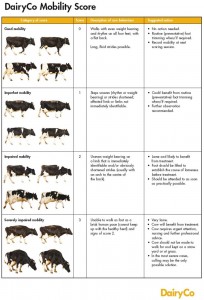
In order to understand what is happening within a herd, the level of lameness needs to be assessed. Click on the image to download the Dairy Co mobility score which can be used to help identify the extent and severity of lame cattle.
Any attempts to control and prevent lameness on-farm must consider the accuracy of lameness detection and recording used. The costs of monitoring need to be weighed against the costs of intervention (Bell, 2005). However, impact assessment of any lameness control strategy needs to be undertaken as part of a thorough herd health plan. This should include information obtained from the vet, the farmer and the foot trimmer if used (Logue et al., 2005).
Assessment of cows for gait abnormalities or lameness may best be done after milking if in a dairy herd, as there is evidence to suggest that this will ascertain the gait more accurately (Flower et al., 2006).
Please also see the welfare assessment page.
Housing
One of the major reasons for increased lameness in herds is reduced lying time. Straw yards, provided they are clean, well bedded and spacious, are excellent in that they provide comfort and the animals are able to move freely. Cows lie down longer in straw yards, and they are better for lying in than many cubicles (Singh et al., 1994). The cows also ruminate more and have improved digestion. Stress due to social status is also reduced in straw yards. Even if animals are not housed in straw yards throughout lactation, it is often useful to place cows into a yard for the first part of lactation. Straw yards are also excellent for wintering suckler beef cows and their followers.
If cubicles are used they should be designed correctly, so they do not cause injury and do provide cow comfort. Overcrowding should be avoided by allowing each cow access to at least one cubicle; extra cubicles can be helpful and at least a 5% surplus of cubicles for the number of cows will reduce the risk of less dominant cows being bullied out of cubicles (please see AHDB Dairy for more information).
Cubicle bases should be kept clean and dry by scraping out slurry at least twice a day and renewing the bedding material as necessary to reduce prolonged contact between their feet and slurry.
Sand is the most comfortable bedding material. If this cannot be used mats or mattresses should be fitted, as they will improve cubicle comfort.
To reduce problems with lameness in heifers which are to come indoors for calving, they should be housed for 6 to 8 weeks prior to calving to acclimatize them to concrete surfaces. If cubicles are used in the main dairy herd, heifers should be trained to lie in them from a young age, preferably by housing with small groups of older cows, for example by housing with dry cows, or including cubicles in some part of the rearing period. If at all possible, heifers should be kept as a separate group during the first lactation, to eliminate bullying by older animals. Ideally, they should be kept in a straw yard during the first lactation, or at least for the first three months of lactation and until after they are pregnant.
Cow tracks are also critical, particularly in situations when cows are required to walk long distances to and from milking. Ensure cows are not hurried when walking to and from pastures. They should not walk for more than 0.5 km on concrete or tar-macadam surfaces. Wherever possible, special cow tracks should be constructed. Passageways inside buildings must be wide enough (2.7 – 3 meters) and kept clean. Scrape out passages regularly and ensure buildings are well ventilated to reduce water pooling. Repair any areas where slurry pooling occurs. Cows should also have enough space at feed barriers (at least 60cms per cow) to avoid excess standing. For more information on the benefits of different types of housing click here.
Specialist advice on floor design should be sought to avoid cows slipping and injuring themselves, but here are some useful suggestions:
- Floor surfaces must not be too slippery nor too rough.
- Concrete surfaces must be cleaned regularly, as both silage effluent and slurry cause erosion
- New concrete surfaces must be well washed before use to remove all the excess surface alkali.
- Slatted floors can cause lameness in cattle due to injuries if the slats are fitted incorrectly or poorly maintained.
Nutrition
Excessive protein levels in the diet, unlikely in pasture based farming systems (except at turnout onto fresh grass in spring), are also known to cause laminitis. This is probably due to excessive ammonia production in the rumen. However, avoid sudden big increases in concentrate feeding early post-calving and restrict concentrate intakes to less than 5 kg per single feed. Including straw and hay in the diet is good practice, as it limits rumen acidity. Inadequate digestible fiber levels and high levels of starchy concentrate in the diet leading to ruminal acidosis should not occur in pasture-based farming, as at least 60% of the diet should consist of fresh or conserved roughage.
Some mineral deficiencies, such as sulfur and zinc deficiencies, may contribute to poor horn formation, and these minerals may need supplementation when dietary supply is insufficient. Vitamins such as biotin may be useful in some situations, however, the entire ration should be reviewed before recommending supplements.
Foot Care
All feet should be checked at least twice yearly. Regular foot trimming by a qualified person is beneficial, as it reduces the risk of foot damage due to misshapen and overgrown hooves. On a herd basis, trimming allows regular examination of the feet and therefore early diagnosis of any lameness lesion. The feet should not be trimmed when the cows are going out on tracks. The dry period is the most convenient period and allows ‘convalescence’.
Foot Bathing
Walk-through and stationary foot-bathing are satisfactory techniques for reducing the incidence and spread of foot infections, such as digital dermatitis and foul-in-the-foot. Solutions of 5-10% zinc or copper sulfate are most commonly used in organic farming. Formaldehyde can be used in concentrations up to 3%, but is subject to restrictions by some certification bodies, and should be handled with extreme care as it is toxic and irritant to both cows and stock workers. Some farmers have used parlor washing disinfectant in foot baths, although there is little evidence of its effectiveness against digital dermatitis. If antibiotics are to be used, solutions of erythromycin and lincomycin-spectinomycin have been used. However, these are off-datasheet uses, and as such, require a 7-day milk withdrawal period following use (minimum of 14 days on organic farms). Foot-bathing should be undertaken during periods of risk, such as early lactation and especially during the autumn and winter housing period. Laven and Hunt (2002) found seven day treatment with non-antibiotic footbaths as effective as a two day treatment with an antibiotic footbath.
Foot-baths are most effective when cows enter the bath with clean hooves. Ideally, two baths should be used in tandem, the first containing just water or parlor washings to clean the feet and the second containing the disinfectant or therapeutic solution. Most permanent foot-baths are placed in the exit passage from the milking parlor or are in a race. Providing a double row of foot baths of space permits can help cow flow.
If the herd is suffering from contagious foot rot, the use of foot baths should be carefully considered as they may act as vectors and spread the disease in the herd. The veterinarian should be consulted before implementing regular foot bathing in a herd.
All foot baths should be kept as clean as possible and after use, foot bathing solution should be carefully disposed of either by pouring into a slurry store system for later spreading or by contacting the local authority if the concentrate solution is to be disposed of.
Breeding
Sires with good linear scores for shape of foot, depth of heel, depth of hock and pastern angle should be selected. Do not breed from cows with a severe clinical lameness or badly deformed legs or feet. This is particularly the case with sole ulcers and corkscrew claws.
More research is needed to establish differences between breeds with regard to susceptibility to lameness. This may help farmers to choose cattle breeds with fewer lameness problems.
Treating Lameness
The treatments below are targeted at the specific causes of lameness, however there are several basic treatments that are common to many foot condition with the aim of reducing the pain and encouraging healing:
- Footbaths – these are not only good for preventing lameness but can also be used to treat it
- Pain control – consult your vet about different pain relief options and
- Foot blocks – these are used to treat a diseased claw, a block is applied to the adjacent sound claw will immobilize the affected claw. However, there is little benefit using blocks if the animal is going to be put back into a straw environment (Watson, 2007).
Treating Horn Diseases
Treating laminitis
Mechanical factors increasing the laminitis risk include housing systems and management factors that decrease lying times and increase stress on the feet (Philipot et al., 1994), such as:
- Cubicle design and overall cow comfort
- Competition for cubicle space
- Cubicle bedding material
- Sudden changes in housing, especially at calving (i.e., moving from straw dry cow yards to cubicle housing)
Nutritional factors have also been implicated in predisposing laminitis (Boosman et al., 1991). These factors include:
- Diets high in starch and low in fiber, leading to ruminal acidosis
- Possibly, diets high in crude protein content
- Sudden, major changes of diet at calving, especially from low to high concentrate diets
- Excessive cow condition at calving, where over-fat cows have a lower appetite for forage and hence are more prone to ruminal acidosis and/or body condition loss
- The way feed is offered – large amounts of concentrates at one time can produce acidosis
Treating sole ulcers
Paring (trimming) of the affected hoof ensures that weight is no longer carried on the injured ulcer area. Existing hemorrhages, any under-run or damaged horn and proud flesh should be removed, whilst the healthy claw may be fitted with a block to remove the weight-bearing from the affected claw and hence promote healing. Antimicrobials should only be considered if there is evidence of infection, additionally, sole ulceration is an extremely painful condition and appropriate use of non-steroidal analgesics should be always be considered.
Treating white line disease
If white line disease is diagnosed, pus must be released and any foreign material pared out. Enough under-run horn has to be removed to ensure drainage, as this will relieve pressure and hence reduce pain. Application of a poultice can be very helpful in drawing out infection. The use of non-steroidal analgesics should be considered if release of the build-up of infected material does provide immediate and significant improvement.
Treating slurry heel
Pare excess horn to remove the grooves and fissures. Abnormal horn growth should be removed and the horn sloped towards the abaxial surface. Both hooves of the foot should be pared to ensure even weight bearing. Ensure that the hoof is clean and isolate the animal on clean bedding until the exposed horn hardens. If slurry heel is a common problem on the farm, the animals should be foot-bathed with copper or zinc sulfate regularly to kill the bacteria. Ensure all passageways, yards and other walking surfaces are kept clean and dry. Lime can be useful around water troughs and other wet and muddy areas. Summer grazing helps the horn to recover and reform.
Antibiotics are not usually required, except where the infection has entered via the fissures into the corium. In such cases, parenteral treatment has been shown to be effective.
Treating Skin Diseases
Treating digital dermatitis
Treatment strategies for DD have tended to be based on topical treatment of individual lesions or mass topical therapy using footbathing (Laven and Logue, 2006). Systemic treatment with antimicrobials does not seem to have a good response.
Individual topical treatment by cleaning (Care should be taken, as this is extremely painful) and use of antimicrobial sprays. The procedure requires proper restraint, raising the foot to examine and clean the lesion and then apply the topical treatment. The procedure requires proper restraint, raising the foot to examine and clean the lesion and then apply the topical treatment. The treatment appears to be most effective if it is allowed to dry and a second application is given, then the cow is allowed to stand in a clean yard for a while (Watson, 2007a). Treatment with tetracycline spray generally has a good response rate (Manske et al., 2002b) and has the advantage of precise targeting of antibiotic usage.
In herds where a severe outbreak of DD occurs, with a high prevalence of infection (>10% of herd affected), foot bathing may be the most appropriate way to treat and control disease. However, there are a number of problematic areas with regards the legislative use of antimicrobials in foot baths and their disposal (Laven and Logue, 2006). Cows with painful lesions must be treated and a short program of foot bathing may help in getting the condition under control. Non-antibiotic foot bath solutions which have been shown to have some effect in reducing lesion severity are copper sulfate, formalin and peracetic acid (Laven and Hunt., 2002). However, these compounds are also not without problems, especially formalin which is potentially toxic (see Foot Bathing). Smith and colleagues found a footbath solution containing tea tree oil and organic acids as effective as one containing copper sulfate (Smith et al., 2014)
Control of DD should center on good biosecurity and control of all other foot diseases.
Identify and treat carrier animals and those with chronic lesions,
- Ensure all cow areas are well scraped regularly,
- Make sure the footbaths are used effectively (Watson, 2007b)
- Good biosecurity as purchased or hired stock can be a source of contamination (Laven, 2001) Insufficiently cleaned and disinfected foot trimming equipment has also been linked with the introduction of l DD into new herds
- Housing of freshly calved heifers in straw yards for the first 4-6 weeks after calving may help prevent disease and be beneficial in terms of heifer health in other areas.
Treating foul-in-the-foot
Affected animals have to be isolated to prevent spread. In outbreaks, house affected animals, using clean, dry bedding, or move to high, well drained pastures. Mild cases may recover spontaneously, but this is rare. Untreated cases often become progressive, affecting the joint and other tissues up the leg, and are then difficult to treat.
The foot should be cleaned off, and necrotic tissue and any foreign body removed. Response to parenteral antimicrobial therapy is usually good following early treatment, with recovery occurring in two to four days. However, in neglected cases recovery may take as long as 10 to between 30 and 45 days (Berg and Loan, 1975).
Regular foot-bathing of the herd may help to control foul-in-the-foot. Both zinc and copper sulfate act as bacteriostats but the foot baths with these chemicals may act as a way of spreading the infection within the herd. A veterinarian should always be consulted before initiating a foot bath procedure in a herd.
Joint diseases
Treating septic arthritis
Involvement of the joint is very serious and requires very prompt and radical treatment by a veterinary surgeon if there is to be any improvement or salvage. Action includes systemic antibiotics and other treatments, such as joint drainage. Treatment of septic arthritis may involve amputation or arthrodesis of the affected joint (Bicalho et al., 2006).
Treating joint-ill
Clean bedding is very important in the calving shed and calf house. Ensure newborn calves receive sufficient colostrum in the first 24 hours of life, particularly in the first 6 hours. The umbilical cord should be treated with a strong iodine solution.
Joint-ill is very serious and requires very prompt and radical treatment with systemic antibiotics by a veterinary surgeon.
Leg Injuries
Treating hock damage and hygromas
Consult your vet for appropriate treatment of hygroma. Severe cases may require surgery to drain them. If joint lesions are a common finding in a herd, then there is a risk that housing conditions may need improving.
For most recent information on different sector body requirements on withdrawal periods for livestock products following medicinal use please see Withdrawal of Products following medication.
Lameness and Welfare
Lameness is one of the biggest welfare problems in cattle, causing pain and discomfort. Lameness is often the result of inadequate housing and management, resulting in reduced lying times, poor hygiene and injuries. The stress of housing and feeding lactating heifers in competition with older cows predisposes them to lameness. A number of other diseases can be more commonly encountered in herds with a high lameness incidence as a consequence of the impact of lameness on the cow’s behavior and production. Therefore, prevention and control of lameness in conjunction with a veterinary surgeon should be a priority in any herd. Lameness incidence recording should be undertaken and evaluated regularly as part of the herd health plan.
The Welfare Code of Recommendations for cattle, paragraph 51, states that ‘Regular attention should be paid to the feet of all classes of cattle’.
Good Practice Based on Current Knowledge
- Keep accurate records on lameness to tackle the disease properly.
- Lameness records should include the following information:
- cow number
- date
- affected limb
- lesion/disease type
- treatments
- outcome of the treatment
- Select breeding bulls with high ‘locomotion’ indices
- The feet of any bought-in animals should be thoroughly checked for lesions and given a footbath in zinc or copper sulfate. The animals should preferably be bought from a herd that has no known history of digital dermatitis or foot rot
- Preference should be given to keeping animals in straw yards over winter; use adequate bedding and hygienic measures
- If cubicles are used, these should be of good design and adequate bedding used to ensure comfortable lying times and prevent injuries
- Maintain concrete surfaces on the farm in good condition to reduce bruising of the sole
- Scrape slurry frequently to improve overall foot health
- Improve cow track conditions to reduce sole penetration and bruising
- Prevent the development of lameness lesions by applying sound routines of foot bathing and foot trimming
- Minimize the risk of laminitis by adopting feeding practices that promote good rumen function, particularly in early lactation
- Ensure healthy feet in first lactation heifers to minimize lameness. They should, preferably, be kept separately from older cows during the first lactation and housed in straw yards
- Monitor feet health by regular herd ‘walk past’ and locomotion scoring and/or feet examination on individual cows at routine trimming to detect problems early and correct accordingly


 American English
American English
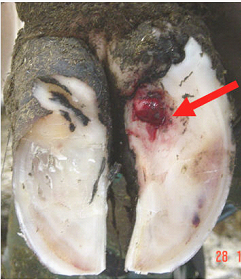
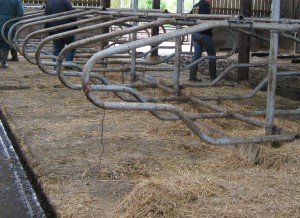
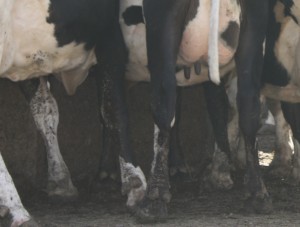
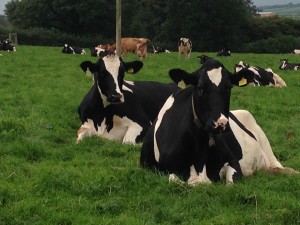
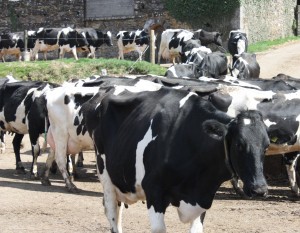

Comments are closed.